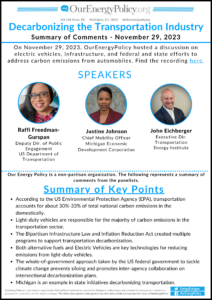The OurEnergyLibrary aggregates and indexes publicly available fact sheets, journal articles, reports, studies, and other publications on U.S. energy topics. It is updated every week to include the most recent energy resources from academia, government, industry, non-profits, think tanks, and trade associations. Suggest a resource by emailing us at info@ourenergypolicy.org.
Resource Library
This report from the Nuclear Energy Agency (NEA) addresses the role of nuclear energy in the climate crisis. The climate crisis is one of the defining challenges of this generation, yet countries are off-track to limit global warming in line with the IPCC 1.5°C scenario and the window for action is narrowing rapidly.
NEA analysis concludes that tripling global installed nuclear capacity provides a realistic and practical path to meet net zero goals by 2050. The world could avoid 87 gigatonnes of cumulative emissions between 2020 and 2050 with a combination of long-term operation (LTO) of existing reactors, new large-scale …
This report provides a detailed meta-analysis of U.S. economy-wide net-zero studies, enabling like-for-like comparisons among different studies and scenarios. The study was performed through a process of collaboration among the authors of each of the five studies evaluated. This meta-analysis brings together a diversity of perspectives, analytical frameworks, and datasets to offer a comprehensive look at designs for net-zero energy systems.…
View Full ResourceThis white paper was prepared on behalf of the Green Energy Consumers Alliance (GECA). It presents a preliminary assessment of costs to customers heating with air-source heat pumps (ASHPs), and discusses the need for alternative electric rate designs to make heating electrification cost effective in Massachusetts. An “operating cost gap” is a measure that can be used to determine whether switching from one heating system to another would be a cost-effective choice for a given household. The “cost gap” is the difference between current and expected future operating costs and can be used to compare different heating systems. A household …
View Full ResourceThe energy transition will require a major scale-up in the deployment of renewable energy with both public and private finance playing critical roles. Aligning with the Paris Agreement targets requires a tripling of total renewable energy capacity in Emerging Markets and Developing Countries (EMDC) by 2030 and significantly augmenting financing flows towards renewable energy projects. However, there is today a global shortage of bankable renewable energy projects available for private investment. Developing a pipeline of bankable projects requires coordinated interventions by governments targeting unique barriers and risks within a country. Governments must deliver the energy transition, while enhancing affordability and …
View Full ResourceHousehold decisions to adopt rooftop solar photovoltaics are partly driven by social influence. Previous research on solar adoption influence has focused on influence among residential peers. Here, they expand the framework of solar adoption influence by exploring the influence of non-residential installations on residential adoption decisions. This report uses staggered differences-in-differences to estimate non-residential influence effects using a large data sample of residential adoptions. It also critically evaluate prevailing frameworks for solar adoption influence. It find that non-residential installations are associated with accelerated residential adoption rates, on the order of 0.4 additional residential adoptions per quarter per non-residential installation. The …
View Full ResourceBanks and other financial institutions (FIs) have an opportunity to leverage emissions models and detection and measurement technologies to inform near-term investment decisions that reduce methane in their energy portfolios. This is part of FIs’ broader strategy to transition oil and gas portfolios in line with climate goals. Methane is a highly potent greenhouse gas (GHG) that is routinely emitted by the oil and gas industry, which accounts for an estimated one-half of their corporate GHG emissions. Yet, equivalent barrels of oil and gas have wide-ranging methane emissions. Combining asset-level emissions modeling — using publicly available, peer-reviewed tools such as …
View Full ResourceThis report offers the most comprehensive English-language analysis to date of China’s climate disclosure regime— the regulations, pressures, and informal norms that drive firms’ decisions around publicizing climate-relevant information about their businesses. The report begins by reviewing the climate disclosures of 39 of China’s largest carbon-emitting firms— its “carbon majors”— to provide a baseline survey of climate disclosure quality among large, emissions-intensive firms. The sample spans seven of China’s highest-emitting industrial sectors and includes both listed and unlisted firms. The Authors combine this review with an analysis of cross-national corporate climate disclosure quality datasets to map China’s climate disclosure regime.…
View Full ResourceRead this resource for a summary of Our Energy Policy’s event on Decarbonizing the Transportation Industry from November 29th, 2023, discussing the need for various decarbonizing approaches and initiatives, including improving Electric Vehicle infrastructure.…
View Full ResourceSome 418 million children worldwide receive at least one school meal per day. However, in developing countries, most school meals are prepared using rudimentary, polluting biomass stove-and-fuel combinations, with unknown costs to the health of students and personnel, school finances, and the local environment. Scant data on the scale of the problem has limited the sector’s visibility, resulting in few investments being designed to meet the clean cooking needs of schools. This report uses primary and secondary data to examine the issue in schools of low- and middle-income countries, with a strong focus on Sub-Saharan Africa, where the access deficit …
View Full ResourceCutting steel sector emissions is essential to limiting global warming to 1.5°C by 2050, and to accomplish this goal, decarbonization and economic strategies must include ambitious action in the Great Lakes. To help state policymakers, economic development offices, and regional NGOs support the Great Lakes steel industry transition, RMI has produced a series of state-specific memos that outline:
1) The scale and enabling environment required for near-zero-emissions steel production
2) Gaps and opportunities for policymakers and other state-level actors to support via policy and infrastructure projects
3) Specific site outlook and recommendations at the facility level…









